#zouave regiment
Explore tagged Tumblr posts
Text

16 notes
·
View notes
Text
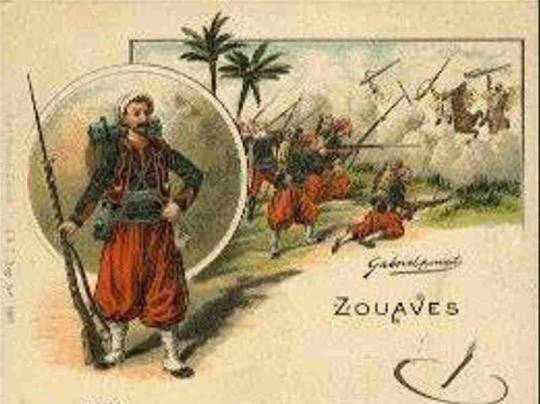

ZOUAVES - The Zouaves were a class of light infantry regiments of the French Army serving between 1830 and 1962 and linked to French North Africa; as well as some units of other countries modelled upon them.
3 notes
·
View notes
Text
“Save the Colors!”
Men of the 5th New York (Zouaves) attempt to recover their colors at the Second Battle of Bull Run (Manassas), 1862. The Regiment would lose 332 out of the 525 men engaged, and would never serve in the battle line again. [Keith Rocco]

#history#military art#1800s#military#soldier#zouaves#american civil war#american uniform#american army#the union#the North#ACW
57 notes
·
View notes
Text
Annette Drevon: cantinière, soldier
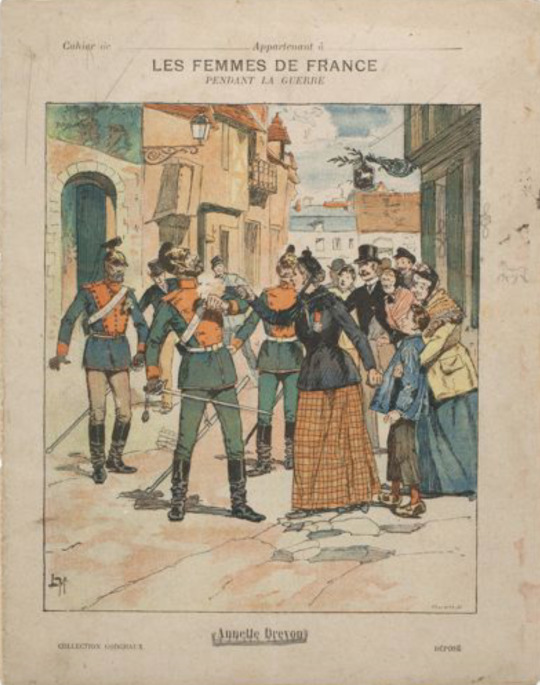
"In 1880, visitors to the markets of Les Halles in Paris might have noticed an especially striking woman sitting at her vegetable stall. In her mid-fifties, with black hair and unwrinkled skin, she had an expression of ‘courage and energy’, which was perhaps unsurprising, given her past. Annette Drevon was a cantinière in the French army, a woman officially deputised to sell food and drink to the soldiers. At the Battle of Magenta in 1859, Annette was attached to the second regiment of Zouaves. During the battle two Austrian soldiers seized the regimental flag. Annette got it back: she killed the first soldier with a sabre and the second with two shots from her revolver. The regiment’s colonel pinned his own Cross of the Legion of Honour to her chest in honour of her actions.
Annette was still serving during the Franco-Prussian War of 1870, where she shot another soldier, this time a German who either insulted her or attempted to steal her Cross; she was sentenced to death but pardoned by Prince Frederick Charles of Hesse, and returned to France. She later received a small pension from Marshal MacMahon, who had commanded the who had commanded the French troops at Magenta, which she used to set up her vegetable stall.
Annette Drevon’s story is a useful reminder that for well over 400 years the normal battlefield was full of ordinary women, who were not only essential to the conduct of war but also demonstrated bravery, physical strength and the ability to stand up to tough conditions – all the things military leaders of the late twentieth century fretted that women could not do."
Forgotten warriors: The long history of women in combat, Sarah Percy
#annette drevon#history#women in history#women's history#france#french history#warrior women#women warriors#historical#historical figure#herstory#19th century#second french empire
78 notes
·
View notes
Text

3rd Regiment of Zouaves of the Constantine Division, Northern France in 1914
83 notes
·
View notes
Text

Few organizations of any size have exerted as marked an effect upon American military ways, and in so brief time and in so dramatic a fashion, as the company formed by Elmer E. Ellsworth in Chicago in 1859. Only a man with his quixotic zeal could have conducted an unbeatable drill team along strict temperance lines with next to no financial or official backing. That his next command, the ‘New York fire zouaves’, was one of the most notoriously undisciplined and unsatisfactory regiments in American history indicates his shallowness as a soldier, but by then he had played out his principal role as the introducing of the zouave to this country.
9 notes
·
View notes
Text
Cathay Williams, first African-American woman to serve in the U.S. Army

November 15, 1866: Cathay Williams became the first African American woman to serve in the U.S. Army, and the only woman to serve in the U.S. Army as a Buffalo Soldier.
Williams was born to an enslaved mother and a free father in Independence, Missouri in 1844. At 17 years old, Williams first served as an Army cook and a washerwoman. During this time, African Americans who had been captured were forced to serve in military support as contraband for Union forces. Williams enlisted in the U.S. Regular Army under the false name “William Cathay” on November 15, 1866. She was assigned to the 38th U.S. infantry Regiment, one of the all-black regiments recently established, that would become part of the renown Buffalo Soldiers. The Army did not require full medical exams at the time, so she was able to pass as a man.
When Williams began to feel the effects of smallpox and was hospitalized, it was discovered that she was actually a woman. Lewis was honorably discharged by her commanding officer, Captain Charles E. Clarke, on October 14, 1868. Following her discharge, Williams went to work as a cook at Fort Union, New Mexico, and later moved to Pueblo, Colorado. Around 1889 or 1890, Williams entered a hospital and applied for disability pension based on her medical service. Her request was denied. In 1893, a doctor’s examination revealed that Willaims suffered from neuralgia and diabetes. She had all her toes amputated and walked with a crutch. The doctor determined that she did not qualify for disability payments. While the exact date of her death is unknown, it is believed that Williams died shortly after she was denied.

Williams’ interview that was published in the St. Louis Daily Times on January 2, 1876:
"My Father a was a freeman, but my mother a slave, belonging to William Johnson, a wealthy farmer who lived at the time I was born near Independence, Jackson county, Missouri. While I was a small girl my master and family moved to Jefferson City. My master died there and when the war broke out and the United States soldiers came to Jefferson City they took me and other colored folks with them to Little Rock. Col. Benton of the 13th army corps was the officer that carried us off. I did not want to go. He wanted me to cook for the officers, but I had always been a house girl and did not know how to cook. I learned to cook after going to Little Rock and was with the army at The Battle of Pea Ridge. Afterwards the command moved over various portions of Arkansas and Louisiana. I saw the soldiers burn lots of cotton and was at Shreveport when the rebel gunboats were captured and burned on Red River. We afterwards went to New Orleans, then by way of the Gulf to Savannah Georgia, then to Macon and other places in the South. Finally I was sent to Washington City and at the time Gen. Sheridan made his raids in the Shenandoah valley I was cook and washwoman for his staff I was sent from Virginia to some place in Iowa and afterwards to Jefferson Barracks, where I remained some time. You will see by this paper that on the 15th day of November 1866 I enlisted in the United States army at St. Louis, in the Thirty-eighth United States Infantry Company A, Capt. Charles E. Clarke commanding. Captain Charles E. Clarke in the Civil War 6th Infantry at the Battle of Baton Rouge. "The regiment I joined wore the Zouave uniform and only two persons, a cousin and a particular friend, members of the regiment, knew that I was a woman. They never 'blowed' on me. They were partly the cause of my joining the army. Another reason was I wanted to make my own living and not be dependent on relations or friends. Soon after I joined the army, I was taken with the small-pox and was sick at a hospital across the river from St. Louis, but as soon as I got well I joined my company in New Mexico. I was as that paper says, I was never put in the guard house, no bayonet was ever put to my back. I carried my musket and did guard and other duties while in the army, but finally I got tired and wanted to get off. I played sick, complained of pains in my side, and rheumatism in my knees. The post surgeon found out I was a woman and I got my discharge. The men all wanted to get rid of me after they found out I was a woman. Some of them acted real bad to me. After leaving the army I went to Pueblo, Colorado, where I made money by cooking and washing. I got married while there, but my husband was no account. He stole my watch and chain, a hundred dollars in money and my team of horses and wagon. I had him arrested and put in jail, and then I came here. I like this town. I know all the good people here, and I expect to get rich yet. I have not got my land warrant. I thought I would wait till the railroad came and then take my land near the depot. Grant owns all this land around here, and it won't cost me anything. I shall never live in the states again. You see I've got a good sewing machine and I get washing to do and clothes to make. I want to get along and not be a burden to my friends or relatives."
youtube
Leticia Wright stars in the 2023 film Surrounded. Her character, Moses “Mo” Washington, was modeled after the Cathay Williams. I’m also seeing a bit of Stagecoach Mary in Wright’s character.
Source: Smithsonian's National Museum of African American History and Culture Facebook, National Park Service, YouTube
Visit www.attawellsummer.com/forthosebefore to learn more about Black history and read new blog posts first.
Need a freelance graphic designer or illustrator? Send me an email.
#Cathay Williams#women in the military#U.S. Army#Buffalo Soldier#1800s#Missouri#1860s#American history#Black history#William Cathay#Colorado history
3 notes
·
View notes
Text
were i a dictator legitimately elected leader i would establish a unit armed with blackpowder weapons just for the hell of it because it sounds cool. a zouave regiment.
3 notes
·
View notes
Photo

July 30 1915 French official photographer takes this photo, IWM Q 115199, French colonial Zouave soldiers (French North Africa) manning a St. Étienne Mle 1907 machine gun in anti-aircraft role at the St. Etienne Aerodrome, Le Bourget
30 July 1915 French official photographer Production date: 1915-07-30
#IWM #Q115199 #FrenchColonialsoldiers #Zouave #StÉtienneMle1907 #machinegun #StÉtienneMle1907machinegun #antiAircraft #antiAircraftGun #StEtienne #Aerodrome #LeBourget #StEtienneAerodrome #WWI #WW1
28 notes
·
View notes
Text


The 155th Pennsylvania Volunteer Infantry Regiment was a Union unit whose recruits mainly came from Pittsburgh and Allegheny.
Initially, the uniform worn by the troops was the standard blue coat and cap worn by the majority of Union troops. However, by 1864, they were issued the colorful Zouave uniform, which was a copy of the uniform worn by the French Army's Zouave light infantry. Such uniforms were considered stylish at the time, although due to their designs were quite hard to replace when damaged.
The 155th Pennsylvania, along with 140th New York, and the 146th New York, all of whom wore Zouave uniforms and were trained in light infantry tactics, would form the Army of the Potomac's Zouave Brigade. However, the 155th Pennsylvania would later on be transfered to another brigade.
Featuring: @f0rever-autumn
#f0rever-autumn#Art#Random Art#MLP#My Little Pony#Unicorn#History#American Civil War#155th Pennsylvania Volunteer Infantry Regiment#Zouaves#Zouave Brigade#The Civil War art continues!#This was really fun to draw#A nice change from the usual blue coats I've done for other units#Also did one with and without glasses cause I'm not sure if I did those glasses well
20 notes
·
View notes
Text










Military ABC
Source : Bibliothèque Nationale de France
1889
#abecedario#abecedarium#abécédaire#militaire#military#1889#zouave#hussar#hussard#horse#army#armée#scots#lancers#regiment#royal horse guards#infantry#cavalry#infanterie#cavalerie#cossack#grenadier#children's books#children's literature#abc#flag
132 notes
·
View notes
Photo


Addy’s school dress is a real classic! In Addy Learns a Lesson, Addy is going to school and making friends. One of the girls she tries to befriend is the snotty Harriet Davis, a light-skinned girl who was born free, has wealthy parents, and lives in the rich Black neighborhood called Society Hill. Harriet was the absolute fucking WORST, but she did teach a few important lessons! She showed that not only were not all African-Americans born enslaved, but that generational wealth for African-Americans existed in the 1860s.

In the original books, Harriet is explicitly lighter-skinned than Addy and her bff, Sarah. The sort story “High Hopes for Addy” introduced me to the concept of colorism and the discrimination that darker-skinned people face. In the newer, updated books, Harriet becomes darker while Addy becomes lighter.

Once again, AG is trying to soften its political edges and remove a very real lesson about privilege, class, and politics.
As far as the fashion goes, Addy has only her pink dress during her first few months of freedom. Harriett gives her a bunch of shit about it, because she’s the fucking worst. Addy receives her blue suit as a surprise so she can wear it to a spelling bee where she finally beats Harriet and puts her in her place.
The suit is a Zouave style, named after regiments of French troops who served in North Africa.

Both the Union and Confederate armies had Zouave units, and the style became very popular everywhere.

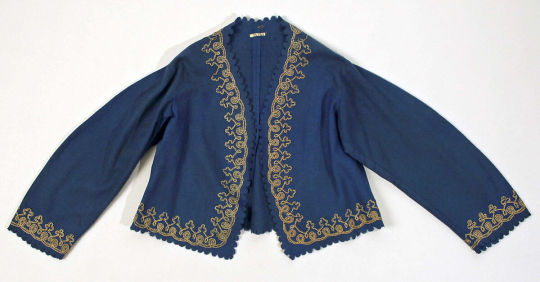
(The Victoria & Albert Museum, finding credit @in-pleasant-company)
The jacket and skirt are decorated with soutache trim, which was also very popular, and could be made into very elaborate designs.
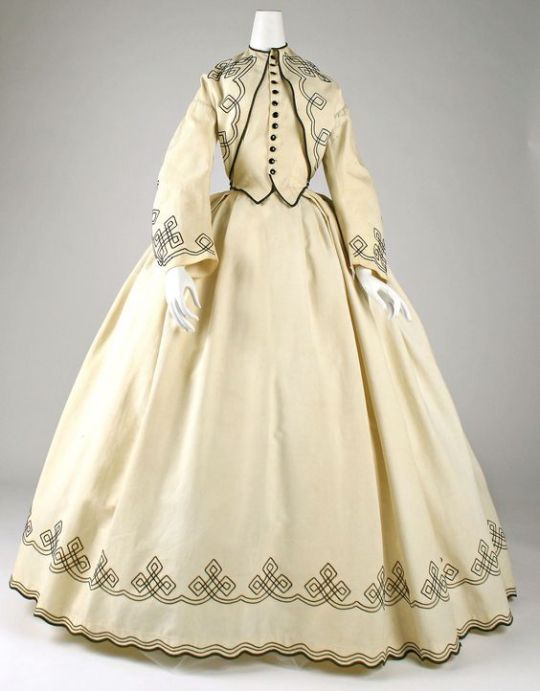
(The Met Museum)
The “Millions for Freedom, Not One Cent for Slavery” pin that Addy receives started out as a campaign slogan for Abraham Lincoln in Nebraska, where it was put on coins that were given out. Soon the saying began appearing on pins.
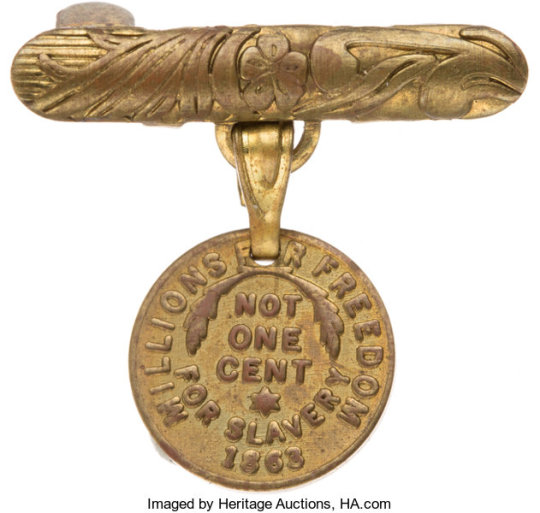
In 2014, Addy was given a BeForever school dress.
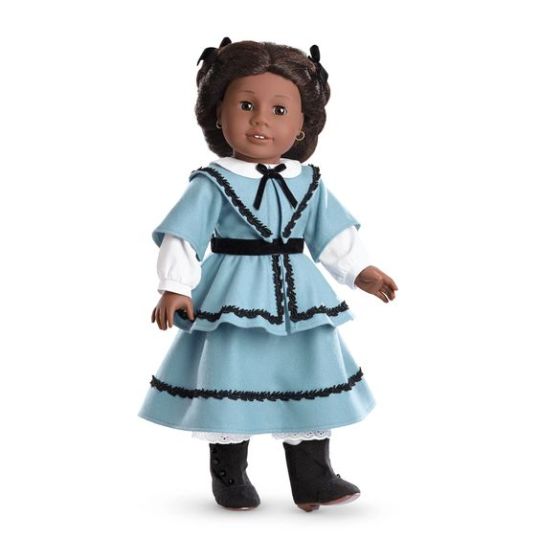
Honestly, it’s not bad. It’s just not nearly as cool as the original.
701 notes
·
View notes
Photo

Zouave Jacket
Zouave units were known for their bravery and drills during the Civil War. Units that demonstrated exceptional skill in drilling were sometimes rewarded with Zouave uniforms. This was the case for the 155th Pennsylvania Volunteer Infantry Regiment.
#zouave#zouave jacket#jacket#style#fashion#1860's#war#civil war#american#amercian#us history#antique#pennsylvania#volunteer regiment#pennsylvania volunteer regiment
56 notes
·
View notes
Note
So, in the English translation of "Destination Moon," Captain Haddock sets off Calculus/Tournesol by saying he's "acting the goat." I'm curious, did he say something similar in the original French, or was it something else that got lost in translation?
It... didn’t really get lost in the translation, but the translation itself got lost in time, kinda? Because “faire le zouave” (the original expression in French) and “acting the goat” used to mean the same thing, which is “behaving wildly”/”showing off” (originally from sarcasms about some of the Zouaves light infantry regiments), but now it’s more “clowning around”. It’s still used fairly often in French for such an old phrase (maaaybe that moment in Tintin has something to do with that fact?).
tl;dr, yep, sorta :D
22 notes
·
View notes
Text




UNIFORM OF SERGEANT JOSEPH TUFFIER, OF THE PONTIFICAL ZOUAVES. The Papal Zouaves were an infantry battalion, later regiment, dedicated to defending the Papal States.
4 notes
·
View notes
Photo



Why was the first Union officer killed in the American Civil War wearing a grey uniform?
On May 21st, 1861 the 11th New York Volunteer Infantry Regiment stormed Alexandria, Virginia, a mere week after Virginia had declared secession from the Union. The regiment’s commander, Col. Elmer Ellsworth, entered a local tavern to remove the Confederate flag that was flying on the roof of the building. While descending the steps with the flag he was ambushed and shot by the tavern’s owner, James W. Jackson, who was in turn bayoneted to death by another soldier. Col. Ellsworth became the first Union officer killed in the American Civil War, and one of the earliest deaths of the war in general. Today his uniform is on display at the New York Military Museum, complete with the bullet hole from his fatal shooting. However, to those not so much versed in Civil War history, something may seem odd about the uniform. Ellsworth was a colonel in the Union Army, but he was wearing a grey uniform.
Most Americans have learned that during the Civil War the Union wore blue and the Confederacy wore grey uniforms. However in the early months of the war this was not a hard and fast rule, more like a suggestion. At the beginning of the Civil War the US Army consisted of three classes of soldiers. The first were the 16,000 regular soldiers who made up the army before the war. These men would have had their regular service uniforms which would have been blue. Then there were the volunteers who enlisted when the war began. While many would have been issued standard uniforms many other units designed their own uniforms which were unique to that regiment. Finally there were local militia companies and regiments who existed before the war and had their own uniforms, most of which were not standard US Army issue. The men of the 11th NY Infantry were of the 2nd category, personally recruited by Ellsworth from New York City firefighters. Ellsworth himself designed the uniform, and since he was part of the zouave fandom, he designed a zouave uniform. Zouaves were originally French light infantrymen stationed in North Africa who wore a unique type of uniform with a North African flair. Since people at the time thought the French were awesome many militaries copied French uniforms. Both the Union and Confederate standard uniform was based on the French pattern. People at the time thought zouaves were especially awesome, so in no time militaries around the Western world were creating their own zouave units. This included Spain, Britain, Italy, Turkey, Brazil, Poland, the United States, and the Confederacy. Ellsworth made his uniform grey most likely because his first command was as the drillmaster of a militia unit called the Rockford Greys, which also happened to be a zouave unit.
11th NY Volunteer Infantry, early war
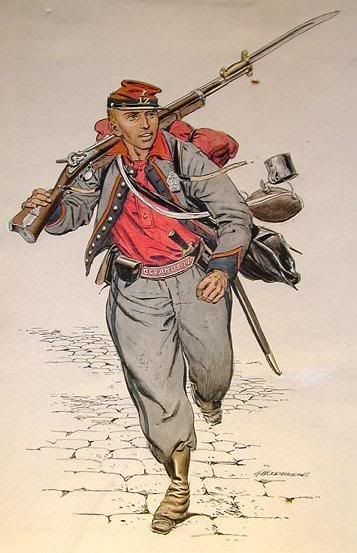
Thus the early Union Army was a hodgpodge of different volunteer and militia units with their own unique uniforms. The Confederate Army had an even bigger problem with uniform standardization as it was an army created completely by scratch comprised entirely of militia with their own unique uniforms or volunteers. Many early Confederate soldiers didn’t even have uniforms and went into battle wearing civilian clothing.
The result was that on both side you had a wide variety of uniforms in a wide variety of styles and colors. There were Union soldiers wearing grey and Confederate soldiers wearing blue. There were soldiers wearing uniforms that were from the wrong century and they might have had time machines.
2nd New Hampshire Militia Regiment
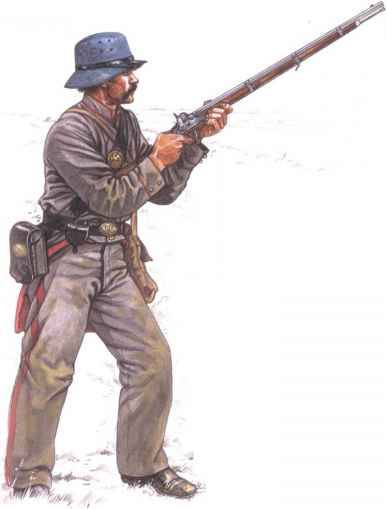
The Amoskeag Veterans, a militia unit from New Hampshire

There were soldiers who wore kilts
79th New York Volunteer Infantry
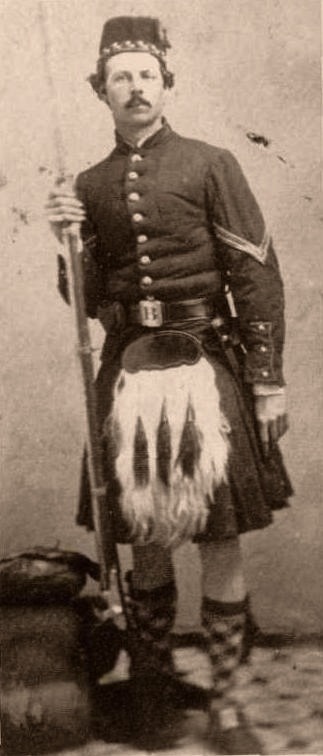
There were soldiers who wore Prussian style pickelhaubs with a skull and crossbone on them
Palmetto Rifles, a militia unit from South Carolina
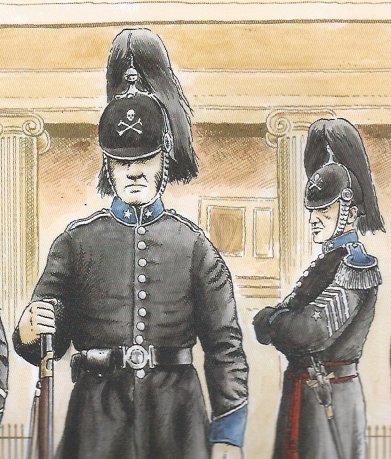
There were soldiers who fought in wars of independence in their home countries and wore the same uniform after immigrating to America.
39th New York Volunteer Regiment, a unit comprised of Italian immigrants, many of whom fought in the Italian Unification Wars.

Literally anything could go. If I find out tomorrow that there was a Union regiment who dressed up as Roman legionaries and a Confederate Regiment who dressed up as Greek hoplites and they fought each other in a small early war skirmish in Kentucky it would not shock me.
This uniform madness all culminated at the First Battle of Bull Run, AKA First Manassas, where the wide variety of uniforms resulted in chaos and confusion. According to Gen. William T. Sherman friendly fire incidents occurred during the battle due the confusion. In one incident, the 33rd Virginia Regiment stormed two Union artillery batteries without being fired upon because they were wearing blue uniforms.
After the Battle of Bull Run both sides began the mass issuance of standardized uniforms to end the confusion and streamline logistics. By 1862 most soldiers had standard issue uniforms. There were some exceptions, most notable were zouave units because zouaves were just the bee knees I’ll tell you what. However, even then Union and Confederate zouaves wore blue and grey respectively. Specialized units might wear special uniforms, for example Union sharpshooters wore green uniforms as an early form of camouflage. Often milita and volunteer regiments wore standard uniforms with unique accessories so that they could retain some uniqueness. For example the 79th NY Infantry continued to wear kilts and the 39th NY Infantry wore their wide brimmed Italian hats with ostrich feathers. The 2nd Wisconsin “Iron Brigade” wore the hardee hat as a distinction because they were an elite unit of shock troops. However for the most part, the uniforms in the Civil War became the same.
2nd Wisconsin Iron Brigade

3rd New Jersey Hussars

44th Mississippi Infantry

994 notes
·
View notes